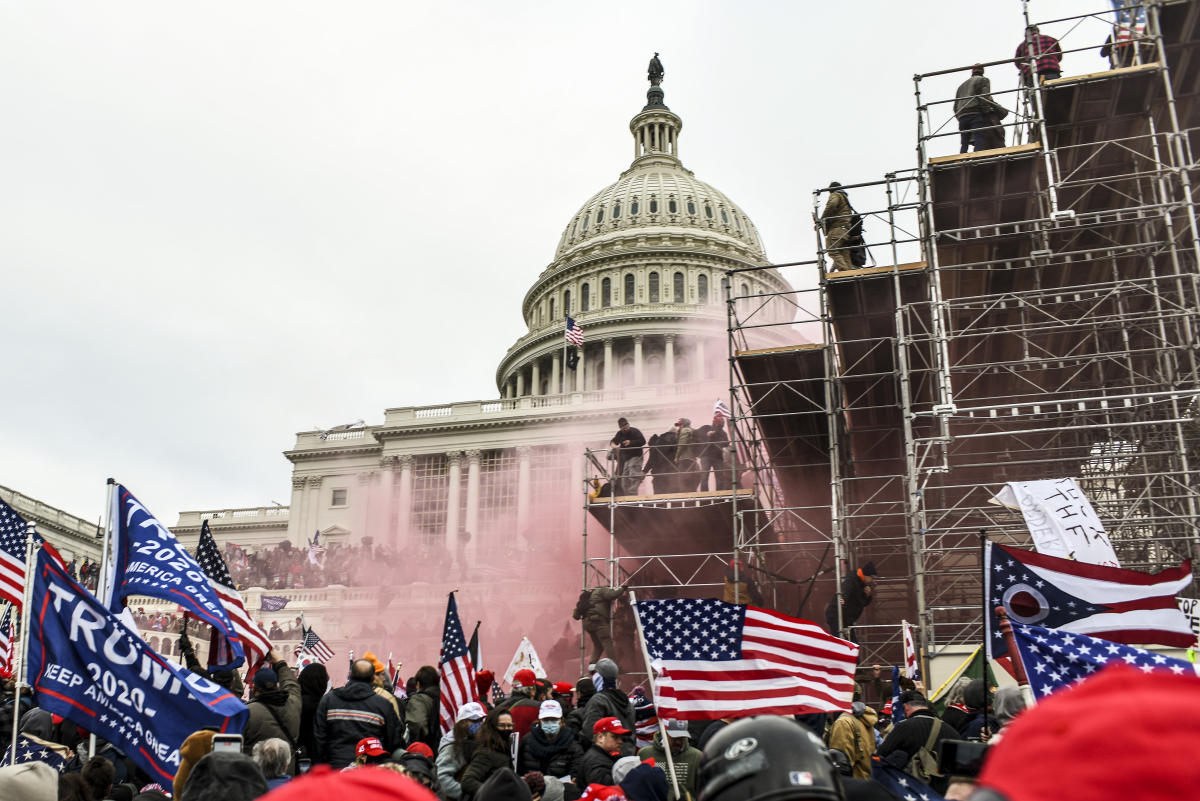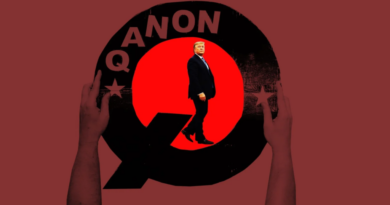Trump’s Evolution in Social Media Exile: More QAnon, More Extremes

In September, former President Donald Trump went on Truth Social, his social network, and shared an image of himself wearing a lapel pin in the form of the letter Q, along with a phrase closely associated with the QAnon conspiracy theory movement: “The storm is coming.”
In doing so, Trump ensured that the message — first posted by a QAnon-aligned account — would be hugely amplified, visible to his more than 4 million followers. He was also delivering what amounted to an unmistakable endorsement of the movement, which falsely and violently claims that leading Democrats are baby-eating devil worshippers.
Even as Meta, the parent company of Facebook and Instagram, announced this past week that Trump would be reinstated — a move that followed the lifting of his ban from Twitter, though he has not yet returned — there is no sign that he has curtailed his behavior or stopped spreading the kinds of messages that got him exiled in the first place.
Sign up for The Morning newsletter from the New York Times
In fact, two years after he was banished from most mainstream social media sites for his role in inciting the Capitol riot, his online presence has grown only more extreme — even if it is far less visible to most Americans, who never use the relatively obscure platforms where he has been posting at a sometimes astonishing clip.
Since introducing his social media website in February 2022, Trump has shared hundreds of posts from accounts promoting QAnon ideas. He has continued to falsely insist that the 2020 election was stolen and that he is a victim of corrupt federal law enforcement agencies. And he has made personal attacks against his many perceived enemies, including private citizens whose names he has elevated.
Now Trump’s increasingly probable return to major platforms raises the prospect that he will carry over his more radicalized behavior to a far wider audience on Facebook and Instagram, with a combined 5 billion active users, and Twitter, with 360 million active users.
The potential for such an outcome has alarmed extremism experts; pushed the platforms to explain that they have installed “guardrails” to deter incendiary posts; and prompted questions about how Trump’s assertions, long siloed in a right-wing arena, are likely to play with mainstream voters, particularly as a sizable share of his party signals that it is ready to move on.
“It’s not that Trump has meaningfully changed the way he behaves online. In fact, he’s grown more extreme,” said Jared Holt, a researcher at the Institute for Strategic Dialogue who studies technology and extremism in the United States. “I don’t think anybody should reasonably expect him to be any different if he’s back on Facebook and Twitter. And when it comes to spreading conspiracy theories, Trump is the big tuna.”
Last month, as Meta considered whether to reinstate Trump, he wrote on Truth Social that even the Constitution should not stand in the way of his return to power.
“A Massive Fraud of this type and magnitude allows for the termination of all rules, regulations, and articles, even those found in the Constitution,” he said.
Steven Cheung, a spokesperson for Trump, said Thursday that “Truth Social has been a success because President Trump has created a true free-speech platform, unlike the Big Tech oligarchs who censor conservatives.” He added, “President Trump should have never been banned on these social media platforms, and everybody knows their decisions were unjust and ultimately destroyed the integrity of our democracy.”
In a letter sent this month to three top Meta officials, including Mark Zuckerberg, the company’s CEO, a lawyer for Trump argued that the ban had “dramatically distorted and inhibited the public discourse.”
The petition for reinstatement was timed to coincide with the second anniversary of the decision to bar him from Facebook and Instagram, made one day after the deadly attack on the Capitol by Trump supporters. At the time, the company said his presence on its sites posed a risk to public safety.
Democrats have said he’s still dangerous. Last month, four of the party’s members of Congress urged Meta not to reinstate Trump, writing in a letter that he was still “undermining our democracy.”
But on Wednesday, Nick Clegg, Meta’s president for global affairs, wrote in a blog post that “our determination is that the risk has sufficiently receded.” He added that the suspension was “an extraordinary decision taken in extraordinary circumstances” and that normally, “the public should be able to hear from a former president of the United States, and a declared candidate for that office again, on our platforms.”
To try to stop Trump from provoking future unrest, Meta said it would prevent sharing of posts that, among other things, question the legitimacy of elections or promote QAnon content. Violations of the company’s policies could also result in his being blocked from the site again, Meta said. Conservatives praised the decision, and the American Civil Liberties Union and Sen. Bernie Sanders defended the move.
No such restrictions exist for Trump on Twitter, which had barred him soon after the Capitol riot but reinstated him in November after Elon Musk, the company’s new owner, conducted a public poll about a possible return.
Trump also often handled his Twitter account directly, unlike his Facebook account. He used the platform as a cudgel during his presidency, issuing a steady flow of stream-of-consciousness thoughts, insults and policy declarations on the fly.
He has been talking to aides about when and what to post on Twitter upon his return, according to two people familiar with the discussions who asked for anonymity.
The former president delivered the first-ever post on Truth Social, in which he has a significant financial stake, in February 2022, writing, “Get Ready! Your favorite President will see you soon!”
He didn’t return for more than two months, but the floodgates then opened, with Trump Truthing and Retruthing — as posts and shares are called — dozens of times a day.
On Aug. 31, for example, he posted more than 50 times, making wild claims about Hunter Biden’s laptop, Dominion voting machines and supposed links by President Joe Biden and Vice President Kamala Harris to Russia.
He has often repeated lies about the 2020 election. This past week, he posted that his infamous phone call seeking more votes in Georgia was “perfect” and that officials had “cheated in many ways including STUFFING Ballots.”
If Trump returns to major social media sites, Republican candidates and elected officials — who spent his presidency dodging questions about his incendiary tweets — are far likelier to be pressed for their opinions on what he says.
Trump would also have to figure out how to manage his online presences.
According to regulatory filings, he is obliged to place his posts exclusively on Truth Social and to not share them elsewhere for six hours. That contract has a significant exception, though, allowing him to post material “that specifically relates to political messaging, political fundraising or get-out-the vote efforts at any time” on other sites.
To date, Trump has not taken advantage of the loophole, posting exclusively to his 4.8 million followers on Truth Social and at times reposting that content to his nearly 800,000 subscribers on Telegram.
Those follower counts pale in comparison to his potential reach elsewhere. A Pew Research Center analysis in October found that only 2% of Americans used Truth Social or Telegram as a regular source for news, compared with 28% for Facebook and 14% for Twitter.
Trump’s own statistics underscore that difference. He has nearly 88 million Twitter followers; his Facebook account has 34 million followers. His Instagram page, which tended to focus more on family photos, has 23 million followers.
According to people close to Trump, he is aware that a return to those platforms would risk starving Truth Social of its largest draw. But it may be that his desire for more income, they said, is outweighed by the enormous attention that Facebook and Twitter can provide him as he runs again for president.
Rashad Robinson, the president of Color of Change, a civil rights group, said Trump’s outsize following could partly explain why Meta made its decision.
“Corporations like Facebook have continued to find ways to profit off Trump even as they’ve condemned him,” said Robinson, whose group has pressured Facebook to enact policy changes through advertiser boycotts. “It’s not just that they let Donald Trump back on their platform; it’s that they benefit from it.”
He and others pointed to the fact that Trump’s campaign spent $89 million to advertise on Facebook and Instagram during the 2020 election and $56 million to advertise on Google and YouTube. (Google, which also suspended Trump from YouTube in January 2021, has not announced plans to reinstate him.)
“Facebook has more followers than Christianity,” Robinson said. “There is not really a comparison point in terms of reach and advertising power.” Meta declined to comment on Robinson’s criticism. But executives have in the past noted that political advertising represents a tiny fraction of the company’s overall revenue, and Meta has acknowledged tweaking its algorithm to downplay political content over the past two years.
The Pew social media study found that Truth Social was “heavily partisan,” with half of its most influential accounts self-identifying as pro-Trump or right-wing.
In a podcast interview in June, Kash Patel, an adviser to Trump and, at the time, a director of the company that owns Truth Social, described the proliferation of QAnon-friendly content on the site as a deliberate business decision by the platform, which has struggled financially.
“We try to incorporate it into our overall messaging scheme to capture audiences,” Patel said. “You can’t ignore that group of people that has such a strong, dominant following.”
While it is possible that Trump will moderate his flow of extreme posts if he returns to mainstream platforms, it is far from clear he will do so.
On Wednesday, Trump showed no sign of slowing down, posting or reposting 19 times on Truth Social about the 2020 election, the news media and the end of what he called his “deplatforming” from Facebook.
“Such a thing should never happen again,” he wrote.
© 2023 The New York Times Company


